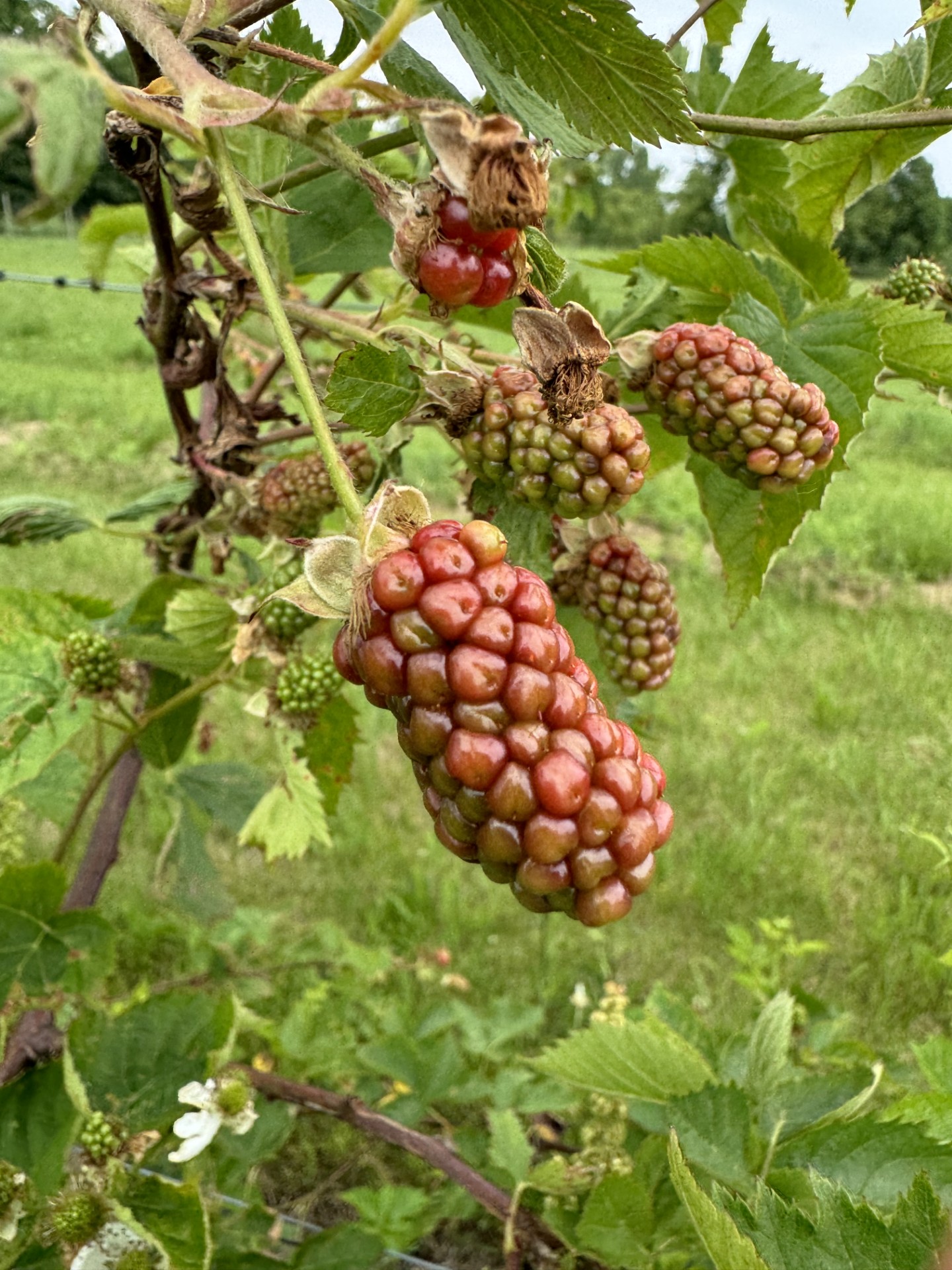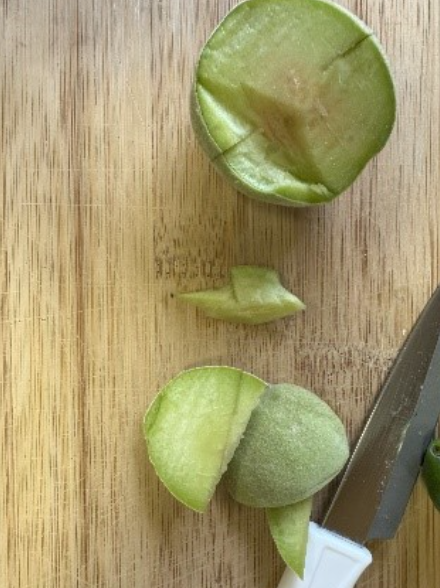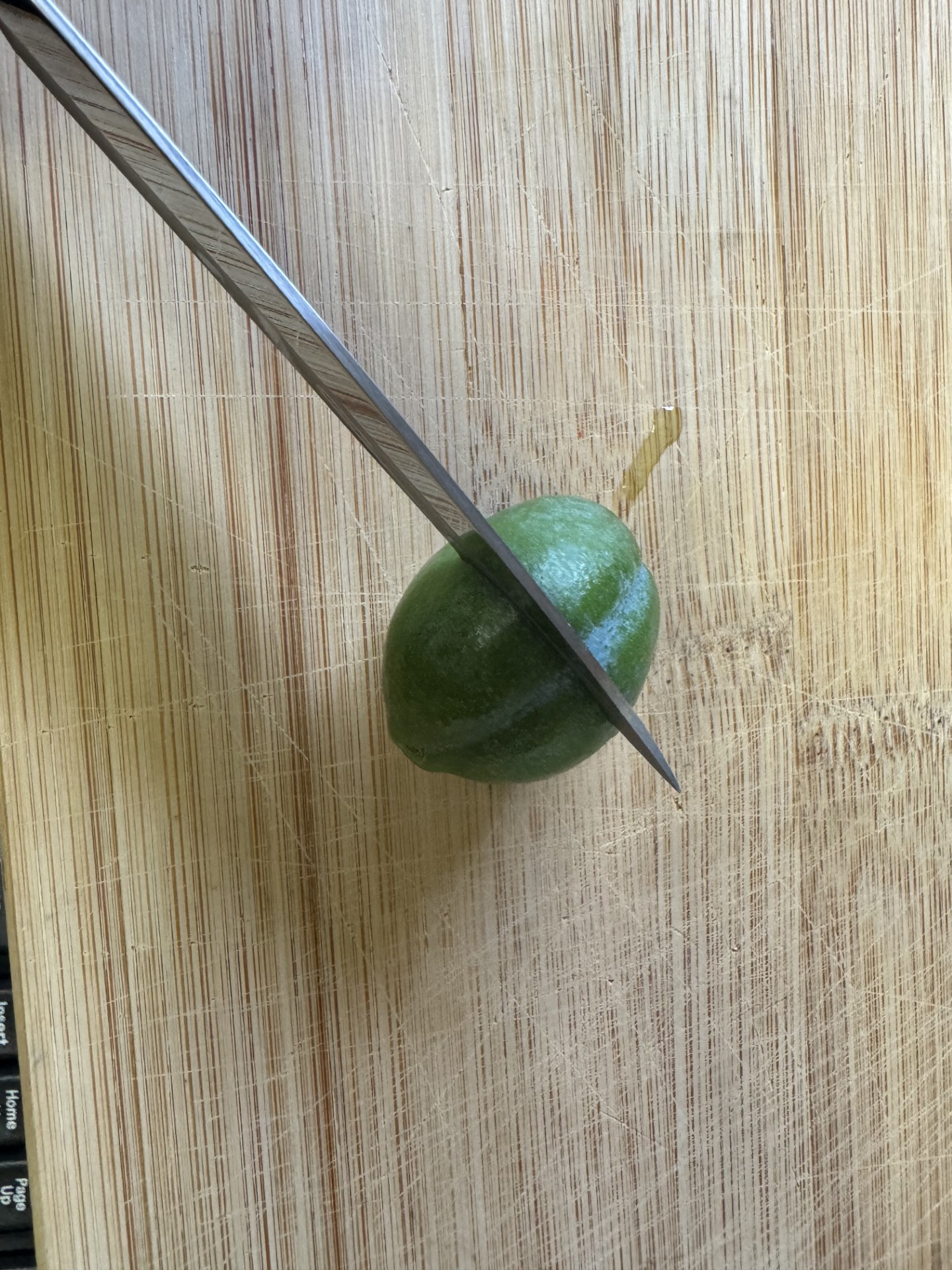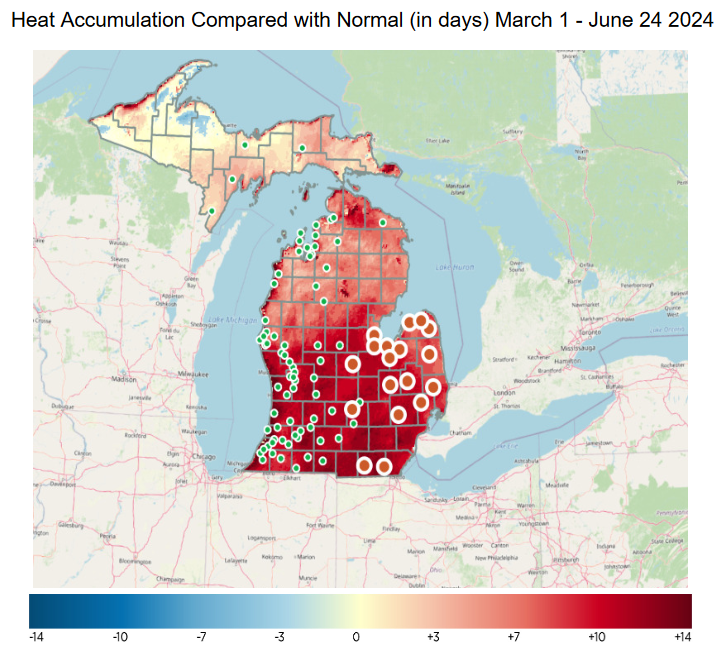Southeast Michigan fruit update- June 25, 2024
Cherry and raspberry harvests continue with blueberries on deck. Spotted lanternfly has been caught in Monroe County.

Welcome to the 10th in-season fruit article update for southeast Michigan for the 2024 season. Throughout the season these updates will include information about the weather in the past week and the upcoming week, a fruit-by-fruit guide to current conditions with appropriate pest and disease updates, and other relevant observations.
General observations
In the week since the last update, many farms have been busy with harvesting raspberries, sweet cherries and tart cherries. Blueberries will likely start in the next week and the earliest peaches in our warmer parts of the region are already starting. Peaches, pears and apples can still be hand-thinned. Fruit set has been good on grapes and the fruit continues to expand.
We’ve seen an average of 1.2 inches of rain in the region over about 12 hours of rainfall in the last week while continued warm temperatures and humidity have brought conditions favorable for disease. When using Enviroweather and other weather models, keep in mind that the weather station closest to you may have different topography or be in the path of weather events that pass by your location. The growing degree-day (GDD) gap is widening and we are even further ahead of previous years on growing degree day accumulation.
The chance of storms continue this week on Wednesday, Friday and Saturday. With these events come increased risk for fungal infections like secondary apple scab and powdery mildew. High temperatures this week will be in the mid-80s. You can see an overview of disease risks on the RimPro interactive location chart. Make sure to check the models frequently as they change with weather forecasts. These weather conditions may make finding a suitable spray date tricky.
Local scouts in southeast Michigan have caught apple maggot, spotted wing drosophila and cherry fruit fly in the region. You can read about the 2024 outlook for spotted wing drosophila in Michigan cherry orchards. Scouts continue to report catches of codling moth males in the region, with numbers remaining moderate; we still appear to be in the first generation. San Jose scale is at the waxing up stage where they are no longer susceptible to larvicidal treatments. Obliquebanded leafroller and oriental fruit moth counts have been down. Scab and fire blight pressure remain low and powdery mildew seems to have been kept under control, but the risk of powdery mildew in tree fruit and grapes remains high.
Yesterday, June 24, the Michigan Department of Agriculture and Rural Development confirmed that spotted lanternfly was caught in Monroe County. You can read the press release here. We have been expecting this to spread to Michigan for some time now (and it was confirmed at a site in Oakland County two years ago in 2022). Watch for additional updates as we get more information.
Our last southern Michigan virtual grower meeting took place yesterday, June 24. You can see recordings of the latest weekly fruit meetings for southern Michigan on MSU’s Kaltura Media Space (these may take a few days to upload after the Monday meetings).
Fruit-by-fruit conditions
Apples
Apples in the region are generally in the 65-65 millimeter (mm) range. June drop has occurred in some orchards and hand thinning can still be done. RimPro indicates that primary scab season is over with all spores being released, but secondary scab risk continues in places that have existing scab infections. Scab and fire blight strikes have been seen in Monroe County, Michigan, and other fire blight strikes have been seen in blocks with historic pressure.
Blueberries
Fruit is sizing up and we are getting close to harvesting blueberries in Fenton, Michigan. We are past the primary season for mummy berry and it’s time to pay attention to fruit rots, Anthracnose and Alternaria. Spotted wing drosophila has been caught in the region. See our Michigan State University Extension collection of factsheets and videos on spotted wing drosophila. Thrips damage has also been observed in the region.
Brambles
Summer red raspberry U-picks have opened and blackberries are sizing up alongside some continued bloom. Spotted wing drosophila has been caught in the region. See our Michigan State University (MSU) Extension collection of factsheets and videos on spotted wing drosophila.

Cherries
Harvest continues in both tart cherries and sweet cherries. Read this article on bird management options for fruit growers. Spotted wing drosophila has been caught in the region. See our MSU Extension collection of factsheets and videos on spotted wing drosopihla.
Grapes
Fruit set in concords, table grapes and cold hardy wine grapes has been good. Diseases of concern include powdery mildew, black rot and Phomopsis. On the insect side, tumid gallmaker is active this time of year.
Strawberries
Strawberry harvest has finished. Renovation should begin as soon as you are done harvesting. This is an important step to ensure continued productivity next season. Read this 2023 article on strawberry renovation for additional information.
Peaches and nectarines
Peaches in Fenton and Romeo have hit the pit hardening stage. Very early peaches like Flaming Fury at our warmest sites have started to be harvested. It is time to think about fungicidal sprays for brown rot for early cultivars.

Pears
Pears observed in Fenton were 50 mm. Some sooty blotch has been seen, which is a problem exacerbated by pear psylla.
Plums
European plums observed in Romeo are at pit hardening but color is not yet changing. The critical periods for most fungal control is from petal fall to late June, but for brown rot specifically, the critical times are during bloom and later on at fruit coloring.

Insect conditions
Like last week in tree fruit, our insect concerns include codling moth, spotted wing drosophila (for cherries) and apple maggot. In small fruit, we’re concerned with grape berry moth and spotted wing drosophila. More in-depth information can be found by watching the latest weekly fruit meetings for southern Michigan on MSU’s Kaltura Media Space (these may take a few days to upload after the Monday meetings).
Aphids: Scouts have seen light infestations of green apple aphids in recent weeks. While some aphids are best controlled during dormancy, woolly apple aphids are controlled during the season. Aphids can stunt shoot growth and pave the way for secondary fungal infections like sooty mold.
Borer complex: With catches of dogwood borer and lesser peachtree borer in Fennville, it is time to review management options for borers. You can read about the current status of Lorsban in this 2024 update. See the 2024 Fruit Management Guide and the article “Timing trunk sprays for the borer complex in cherries.” While chlorpyrifos is available for use this season, alternatives materials may be used to manage borers as well. Assail is a recommended material for a trunk spray once adult borers are active.
Cherry fruitworm: Scouts in the state have caught cherry fruitworm.
Codling moth: Codling moth catches remain moderate and we have yet to reach the drop in numbers between generations. You can track the codling moth model on Enviroweather.
Cranberry fruitworm: Scouts in the state have caught cranberry fruitworm.
Grape berry moth: Grape berry moth has been caught, but control is usually most effective in the second and third generations. See this early season grape berry moth management article.
Japanese beetle: These are generalist feeders with a single generation per season. They have been seen in the region. If needed, insecticides can be used to control populations.
Oriental fruit moth: Counts remain low, indicating we do not have an emerging second generation. If control for the first generation wasn’t effective, sprays may be needed to control egglaying and larvae in the subsequent generation.
Pear psylla: This may need control throughout the season.
Potato leafhopper: Populations can build quickly in June and peak in July. These can cause leaf margins to brown and are a bigger issue in young plantings.
Raspberry sawfly: Adults emerge in the spring and lay eggs on leaves before bloom. Larvae feed on the leaves.
San Jose scale: San Jose scale is at the “waxing up” stage where larvae are protected from sprays. Characteristic spots on fruit are starting to appear in some locations. See the 2024 Fruit Management Guide.
We have moved past the control periods for rosy apple aphid, mites, green fruitworm, oriental fruit moth, tarnished plant bug, plum curculio and black stem borer.
Disease conditions
Apple scab: We are at the end of primary scab season and models are not predicting secondary infection risk in the next week. Scab pressure seems light this year.
Black knot: There is still time to prune out and burn black knot in plums and sour cherries. Fungicides may be used for limited control to supplement pruning and sanitation efforts.
Brown rot: This disease affects stone fruit and can proliferate during bloom. The next chance to control is about three weeks before harvest when fruits start to color.
Cherry leaf spot: We expect risk of infection on June 22. See this 2013 article on cherry leaf spot management.
Fire blight: Some fire blight strikes have been reported in orchards that have had fire blight in past years, but there do not appear to be many new infections this year. Read this 2020 article from George Sundin for fire blight management options.
Fruit rots: Rots like bitter rot and black rot can be controlled as early as first cover in apples. Humid, warm nights like the ones we have been experiencing activate infections
Grape black rot: There is potential conidi infection on June 22 in the region. See this 2014 article for grape black rot management options and consult the 2024 Fruit Management Guide.
Orange rust: With our advanced growing degree-days this year, we have hit the risk period for orange rust in brambles early. Read the linked article for control options.
Peach leaf curl: Symptoms are starting to appear, control needed to be done before bud break. The next chance to control it will be with fall sprays.
Phomopsis: In blueberries, the Phomopsis fungus is active from bud swell until after harvest.
Powdery mildew of apple and pear: You can start to include products labeled for powdery mildew in sprays starting at tight cluster. We are in a high risk period for infection for all of the next week.
Powdery mildew and downy mildew of grape: Scouting should start early for these diseases. There is risk of powdery and downy mildew infections on June 25-26 and July 3-4 in the region. Read the linked article for control options.
While not a disease, nutrient deficiencies can leave plants more susceptible to disease. Now that the plants have leafed out you can start to see some symptoms. These diseases can be hard to definitively diagnose without nutrient testing, but this article from Eric Hanson is a handy guide to what nutrient deficiency symptoms look like.
Seasonal weather update
In the past few week, southeast Michigan has seen hot weather with an average of over 12 hours of rain accumulating to 1.2 inches of precipitation. We are ahead of the five-year average in both time and amount of rainfall.
| Liquid Precipitation Accumulation Jan. 1 - June 25, 2024, issued June 25, 2024 | ||||
|---|---|---|---|---|
| Station (County) | Rainfall Total (in.) Current | Hours with Rainfall Current | Rainfall Total Average (5 Yr.) | Hours with Rainfall Average (5 Yr.) |
| Commerce (Oakland) | 14.4 | 283 | 12.9 | 265 |
| Deerfield (Monroe) | 16.8 | 316 | 14.1 | 275 |
| East Lansing MSU Hort (Ingham) | 13.5 | 264 | 12.9 | 263 |
| Emmett (St. Clair) | 13.8 | 296 | 12.1 | 288 |
| Flint (Genesee) | 15.3 | 300 | 12.8 | 274 |
| Freeland (Saginaw) | 12.0 | 240 | . | . |
| Hudson (Lenawee) | 16.3 | 299 | 13.3 | 277 |
| Ithaca (Gratiot) | 12.8 | 327 | 12.6 | 240 |
| Lapeer (Lapeer) | 14.8 | 341 | 10.6 | 255 |
| Linwood (Bay) | 13.2 | 262 | 12.2 | 243 |
| Pigeon (Huron) | . | . | . | . |
| Richville/Frankenmuth (Tuscola) | 15.1 | 282 | 11.4 | 236 |
| Sandusky (Sanilac) | 11.7 | 334 | 11.0 | 234 |
| Romeo (Macomb) | 15.8 | 284 | 12.6 | 248 |
| Average of stations in this region: | 14.3 | 294.5 | 12.4 | 258.3 |
| Difference in Liquid Precipitation Accumulation from Jan. 1 observed June 17 and June 25, 2024; issued June 25, 2024 | ||||||
|---|---|---|---|---|---|---|
| Rainfall Total (in.) | Rainfall Total (in.) | Hours with Rainfall | Hours with Rainfall | |||
| Station (County) | 17-Jun | 25-Jun | Difference | 17-Jun | 25-Jun | Difference |
| Commerce (Oakland) | 14.0 | 14.4 | 0.4 | 275 | 283 | 8.0 |
| Deerfield (Monroe) | 15.8 | 16.8 | 1.0 | 307 | 316 | 9.0 |
| East Lansing MSU Hort (Ingham) | 12.9 | 13.5 | 0.6 | 256 | 264 | 8.0 |
| Emmett (St. Clair) | 12.4 | 13.8 | 1.4 | 283 | 296 | 13.0 |
| Flint (Genesee) | 13.2 | 15.3 | 2.0 | 286 | 300 | 14.0 |
| Freeland (Saginaw) | 10.6 | 12.0 | 1.5 | 224 | 240 | 16.0 |
| Hudson (Lenawee) | 16.0 | 16.3 | 0.3 | 295 | 299 | 4.0 |
| Ithaca (Gratiot) | 11.9 | 12.8 | 0.9 | 310 | 327 | 17.0 |
| Lapeer (Lapeer) | 13.8 | 14.8 | 1.0 | 328 | 341 | 13.0 |
| Linwood (Bay) | 12.0 | 13.2 | 1.2 | 245 | 262 | 17.0 |
| Pigeon (Huron) | . | . | . | . | . | . |
| Richville/Frankenmuth (Tuscola) | 13.3 | 15.1 | 1.8 | 264 | 282 | 18.0 |
| Sandusky (Sanilac) | 10.6 | 11.7 | 1.1 | . | 334 | . |
| Romeo (Macomb) | 13.9 | 15.8 | 1.9 | 272 | 284 | 12.0 |
| Average of stations in this region: | 13.1 | 14.3 | 1.2 | 278.8 | 294.5 | 12.4 |
In the short term, we are expecting variable conditions with thunderstorms possible Wednesday, Friday and Saturday. The warm and humid conditions will continue. High temperatures this week will reach the mid-80s, but we won’t see the same heat as we saw last week.
The long lead outlooks are still calling for warmer than normal conditions for the late spring and summer seasons with normal precipitation levels.
Our regional average growing degree-day accumulation for the season are ahead of the five-year average by 336 GDD at 42 F, 291 GDD at 45 F and 216 GDD at 50 F (see table below). This puts us one to two weeks ahead of normal in most of the region. Read this Michigan State University Extension article to learn more about degree days: Understanding growing degree-days.
| Degree Day Accumulation Jan. 1 -June 25, 2024, Forecast from June 25-July 1, 2024; issued June 25, 2024 | |||||||||
|---|---|---|---|---|---|---|---|---|---|
| Station (County) | Degree Days Base 42°F Current | Degree Days Base 42°F Average (5 Yr.) | Degree Days Base 42°F Forecast | Degree Days Base 45°F Current | Degree Days Base 45°F Average (5 Yr.) | Degree Days Base 45°F Forecast | Degree Days Base 50°F Current | Degree Days Base 50°F Average (5 Yr.) | Degree Days Base 50°F Forecast |
| Commerce (Oakland) | 1682 | 1344 | 1827 | 1413 | 1118 | 1543 | 1018 | 797 | 1123 |
| Deerfield (Monroe) | 1907 | 1506 | 2063 | 1616 | 1259 | 1758 | 1187 | 909 | 1304 |
| East Lansing MSU Hort (Ingham) | 1792 | 1403 | 1932 | 1514 | 1173 | 1639 | 1100 | 844 | 1200 |
| Emmett (St. Clair) | 1561 | 1254 | 1696 | 1299 | 1036 | 1419 | 915 | 729 | 1010 |
| Flint (Genesee) | 1808 | 1452 | 1950 | 1531 | 1217 | 1658 | 1117 | 878 | 1220 |
| Freeland (Saginaw) | 1634 | 1323 | 1774 | 1373 | 1104 | 1497 | 989 | 792 | 1088 |
| Hudson (Lenawee) | 1813 | 1404 | 1969 | 1536 | 1173 | 1677 | 1127 | 844 | 1242 |
| Ithaca (Gratiot) | 1766 | 1401 | 1906 | 1496 | 1179 | 1620 | 1092 | 855 | 1192 |
| Lapeer (Lapeer) | 1679 | 1337 | 1814 | 1411 | 1112 | 1531 | 1015 | 795 | 1110 |
| Linwood (Bay) | 1499 | 1238 | 1631 | 1248 | 1027 | 1365 | 880 | 727 | 973 |
| Pigeon (Huron) | 1504 | 1222 | 1639 | 1249 | 1015 | 1369 | 884 | 720 | 979 |
| Richville/Frankenmuth (Tuscola) | 1700 | 1395 | 1836 | 1432 | 1170 | 1554 | 1031 | 847 | 1128 |
| Sandusky (Sanilac) | 1568 | 1255 | 1702 | 1308 | 1043 | 1428 | 933 | 741 | 1028 |
| Romeo (Macomb) | 1688 | 1368 | 1831 | 1416 | 1138 | 1545 | 1017 | 810 | 1120 |
| Average of stations in this region: | 1686 | 1350 | 1826 | 1417 | 1126 | 1543 | 1022 | 806 | 1123 |
| Difference in Degree Day Accumulation from Jan. 1 observed June 17 and June 25, 2024; issued June 25, 2024 | |||||||||
|---|---|---|---|---|---|---|---|---|---|
| Station (County) | Degree Days Base 42°F | Degree Days Base 42°F | Degree Days Base 42°F | Degree Days Base 45°F | Degree Days Base 45°F | Degree Days Base 45°F | Degree Days Base 50°F | Degree Days Base 50°F | Degree Days Base 50°F |
| 17-Jun | 25-Jun | Difference | 17-Jun | 25-Jun | Difference | 17-Jun | 25-Jun | Difference | |
| Commerce (Oakland) | 1416 | 1682 | 266.0 | 1171 | 1413 | 242.0 | 816 | 1018 | 202.0 |
| Deerfield (Monroe) | 1624 | 1907 | 283.0 | 1357 | 1616 | 259.0 | 968 | 1187 | 219.0 |
| East Lansing MSU Hort (Ingham) | 1522 | 1792 | 270.0 | 1268 | 1514 | 246.0 | 894 | 1100 | 206.0 |
| Emmett (St. Clair) | 1303 | 1561 | 258.0 | 1065 | 1299 | 234.0 | 721 | 915 | 194.0 |
| Flint (Genesee) | 1531 | 1808 | 277.0 | 1278 | 1531 | 253.0 | 905 | 1117 | 212.0 |
| Freeland (Saginaw) | 1384 | 1634 | 250.0 | 1146 | 1373 | 227.0 | 802 | 989 | 187.0 |
| Hudson (Lenawee) | 1529 | 1813 | 284.0 | 1276 | 1536 | 260.0 | 907 | 1127 | 220.0 |
| Ithaca (Gratiot) | 1503 | 1766 | 263.0 | 1257 | 1496 | 239.0 | 893 | 1092 | 199.0 |
| Lapeer (Lapeer) | 1418 | 1679 | 261.0 | 1174 | 1411 | 237.0 | 818 | 1015 | 197.0 |
| Linwood (Bay) | 1260 | 1499 | 239.0 | 1033 | 1248 | 215.0 | 706 | 880 | 174.0 |
| Pigeon (Huron) | 1257 | 1504 | 247.0 | 1026 | 1249 | 223.0 | 701 | 884 | 183.0 |
| Richville/Frankenmuth (Tuscola) | 1443 | 1700 | 257.0 | 1199 | 1432 | 233.0 | 839 | 1031 | 192.0 |
| Sandusky (Sanilac) | 1312 | 1568 | 256.0 | 1076 | 1308 | 232.0 | 741 | 933 | 192.0 |
| Romeo (Macomb) | 1420 | 1688 | 268.0 | 1172 | 1416 | 244.0 | 813 | 1017 | 204.0 |
| Average of stations in this region: | 1423 | 1686 | 263 | 1178 | 1417 | 239 | 823 | 1022 | 199 |

Watch Jeff Andresen's Weekly Agricultural weather forecast reports here.
More information and reports on normal weather conditions and departures from normal can be found on the NOAA Climate Prediction Center website, NOAA U.S. Climate Normals website, NOAA Climate Normals Quick Access Page (which may be searched by region), and Midwest Regional Climate Center website.



 Print
Print Email
Email


